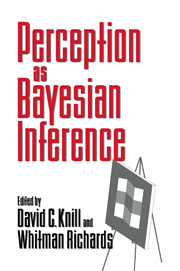Book contents
- Frontmatter
- Contents
- List of contributors
- Preface
- 0 Introduction
- Part one Bayesian frameworks
- Commentaries
- Part two Implications and applications
- 6 Implications of a Bayesian formulation of visual information for processing for psychophysics
- 7 Shape from texture: Ideal observers and human psychophysics
- 8 A computational theory for binocular stereopsis
- 9 The generic viewpoint assumption in a Bayesian framework
- 10 Experiencing and perceiving visual surfaces
- 11 The perception of shading and reflectance
- 12 Banishing the homunculus
- Commentaries
- Author index
- Subject index
6 - Implications of a Bayesian formulation of visual information for processing for psychophysics
Published online by Cambridge University Press: 05 March 2012
- Frontmatter
- Contents
- List of contributors
- Preface
- 0 Introduction
- Part one Bayesian frameworks
- Commentaries
- Part two Implications and applications
- 6 Implications of a Bayesian formulation of visual information for processing for psychophysics
- 7 Shape from texture: Ideal observers and human psychophysics
- 8 A computational theory for binocular stereopsis
- 9 The generic viewpoint assumption in a Bayesian framework
- 10 Experiencing and perceiving visual surfaces
- 11 The perception of shading and reflectance
- 12 Banishing the homunculus
- Commentaries
- Author index
- Subject index
Summary
Introduction
The previous chapters have demonstrated the many ways one can use a Bayesian formulation for computationally modeling perceptual problems. In this chapter, we look at the implications of a Bayesian view of visual information processing for investigating human visual perception. We will attempt to outline the elements of a general program of empirical research which results from taking the Bayesian formulation seriously as a framework for characterizing human perceptual inference. A major advantage of following such a program is that it supports a strong integration of psychophysics and computational theory, since its structure is the same as that of the Bayesian framework for computational modeling. In particular, it provides the foundation for a psychophysics of constraints, used to test hypotheses about the quantitative and qualitative constraints used in human perceptual inferences. The Bayesian approach also suggests new ways to conceptualize the general problem of perception and to decompose it into isolatable parts for psychophysical investigation. Thus, it not only provides a framework for modeling solutions to specific perceptual problems; it also guides the definition of the problems.
The chapter is organized into four major sections. In the next section, we develop a framework for characterizing human perception in Bayesian terms and analyze its implications for studying human perceptual performance. The third and fourth sections of the chapter apply the framework to two specific problems: the perception of 3-D shape from surface contours and the perception of 3-D object motion from cast shadow motion.
Information
- Type
- Chapter
- Information
- Perception as Bayesian Inference , pp. 239 - 286Publisher: Cambridge University PressPrint publication year: 1996
Accessibility standard: Unknown
Why this information is here
This section outlines the accessibility features of this content - including support for screen readers, full keyboard navigation and high-contrast display options. This may not be relevant for you.Accessibility Information
- 10
- Cited by
